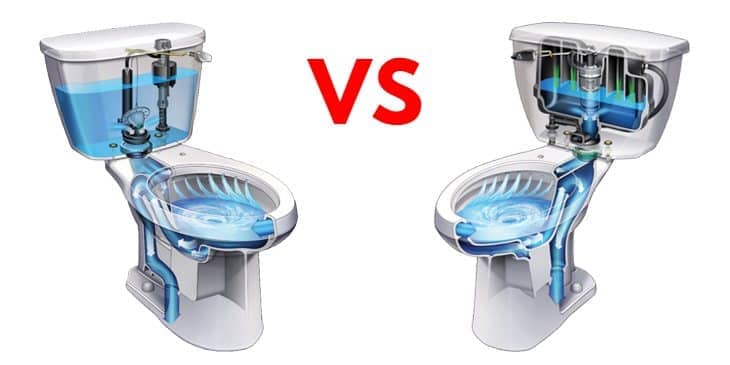With about 15 years of experience in this industry, I have seen the evolution of toilets from gravity fed to the siphonic jet.
If a comparison was made between siphonic jet vs gravity fed toilet, which one would win? The older, classic toilet or the newer, advanced technology?
Having knowledge of the toilet flushing system is a fundamental part of choosing the right toilet for your bathroom. The toilet’s performance greatly depends on it. Out of the numerous toilet flushing systems, the siphonic jet and the gravity fed are the most powerful ones on the market right now!
An Introduction to the Siphonic Jet Toilet
The siphonic jet, as the name suggests, creates a siphon effect while flushing the waste matter away. And the construction of the drain is done in such a manner that the suction power is greater and the flush time is shorter.
Now, the characteristic shape of the siphon jet toilet includes either an S-shaped or reverse-P trap way.
The trap way has two sides, one side is attached to the inlet of the toilet bowl, and the other end is connected to the plumbing.
Its most useful feature is that the water level in the toilet bowl is higher. This sort of siphonic jet toilet is more common in the United States.
The Working Mechanism of a Siphonic Jet Toilet
Its mechanism is very similar to most standard toilets, other than the fact that this toilet creates a vacuum during flushing, hence its name.
Pressing the lever causes the water to be released from the cistern into the toilet bowl, where the water rises and then rapidly washes away the waste.
This swift washing away of waste content prevents any streaks from remaining on the toilet bowl.
The gurgling sound implies the refilling of the water tank. The siphoning action contributes to its powerful flushing system, which is created by the difference in water flow rate during entry and exit into the bowl.
Amount of Water Used by a Siphon Jet Toilet
Most of the models employ copious amounts of water — 4 gallons to be exact. However, the implementation of government regulations to save water compelled manufacturers to limit water usage to 1.6 gallons for each flush. Hence, the more recent models of the siphon toilet jet are efficient!
Reasons for Going with Siphonic Jet Toilets
Now, to sum all its wow factors together, the siphonic jet’s high levels of water in the toilet bowl enable better flushing and additionally prevent the noxious gasses from the pipes below from diffusing out.
If compared to a gravity-fed toilet, the water level is almost twice as higher.
The powerful siphon jet system also ensures a much cleaner bowl and minimal traces of waste marks, which is definitely a plus point. On top of that, they are not as noisy as you would expect them to be!
An Introduction to the Gravity-Fed Toilets
The gravity-fed toilet is the most commonly used toilet flushing system utilized in Europe; however, they are gaining more popularity around the world. This type of toilet uses the most basic concept of physics, gravity!
Mechanism of the Gravity-Fed Toilet
The tramway from the toilet bowl to the plumbing is a straight path where gravity pulls the waste matter away from the toilet bowl. The gravitational force is simply from the sheer force and the water weight.
Pressing the lever button enables the forceful release of water into the toilet bowl, which washes away the waste. This also poses a great advantage, that is, you can practically never get a clogged toilet because of the straight pathway.
Amount of Water Utilized by the Gravity-Fed Toilet
The gravity-fed toilet’s trademark characteristic is the usage of minimal water and hence reducing water wastage.
Its dual-flush design also allows you to choose between the strength of flush required and hence contributes to reduced water waste. A full flush requires 1.6 gallons, compared to 0.8 gallons for a half flush.
You can also read the comparison between: 1.28 VS. 1.6 GPF Toilets: Which One Is Best For You?
Reasons for Going with Gravity-Fed Toilet
The simple gravity-fed toilet is an environment-friendly and even space-friendly toilet. This is because it uses a rather less amount of water and also requires little space in a bathroom. This toilet type can be the perfect type for a smaller space. The added advantage of low clogging probabilities also is a big point to consider.
Siphonic Jet vs Gravity-Toilets: Pros and Cons
Now comes the time to finally compare the advantages and disadvantages of the two commonly used toilet jet types.
Pros of the Siphonic Jet Toilet
- Powerful flushes enable a faster and cleaner flush, leaving minimum skid marks on the toilet bowls
- Extremely easy to maintain and clean-up!
- The faster flush time and the vacuum means that odor is minimum
Pros of the Gravity-Fed Toilet
- Its hallmark advantage is utilizing less water, attracting many customers who seek to contribute to a better earth
- The straight trap way of the toilet makes it almost difficult to clog as the primary mechanism of waste removal is gravitational pull
- Compact design of the toilet ensures that it takes the least space
Cons of Siphonic Jet Toilet
- S-shaped or reverse-P-shaped system increases the probability of clogging
- Requires a large amount of water
- Toilets are larger in general, hence taking up more space
Cons of Gravity-Fed Toilet
- Lower levels of water mean that things may get a bit smelly
- Lack of a vacuum means that it is prone to leaving streaks
Siphonic Jet Vs. Gravity-Fed Toilet: Who’s the Winner?
A winner from the siphonic jet vs gravity fed toilet comparison is for yours to pick as you have to consider space, water amount, and price. For me, I’d choose siphonic jet as the technology is new, and it keeps the odor in check very effectively.
